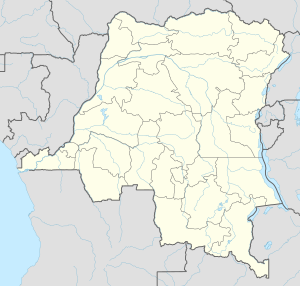Matadi bridge
Coordinates: 5 ° 49 ′ 31 ″ S , 13 ° 26 ′ 2 ″ E
| Matadi bridge | ||
|---|---|---|
| use | Road bridge | |
| Crossing of | Congo | |
| place |
Matadi , DR Congo (Congo-Kinshasa) |
|
| construction | Suspension bridge | |
| overall length | 722 m | |
| Longest span | 520 m | |
| completion | 1983 | |
| location | ||
|
|
||
The Matadi Bridge is a road bridge over the Congo or Rio Zaire near the port city of Matadi in the Democratic Republic of the Congo, about 135 km from the Atlantic . It is one of the few bridges over the Congo - the next bridge is about 2,800 km upstream at Kangolo on Lualaba in Katanga . The Matadi Bridge was the largest suspension bridge in Africa until the Maputo – Katembe bridge opened on November 10, 2018 .
The bridge extends the road from Kinshasa to Matadi to the north of the river in the province of Congo Central , in particular to the downstream towns of Boma and Banana , a town on the Atlantic with an oil terminal. It was originally intended as a combined road and rail bridge to also run the Matadi-Kinshasa Railway across the Congo. A track was to be installed below the roadway within the unusually high-looking roadway girder. But that never happened.
The bridge was built by Kawasaki Heavy Industries from 1979 to 1983 under the rule of Mobutu Sese Seko as part of a Japanese development aid program and was accordingly called Pont Maréchal Mobutu Sese Seko ( Marshal Mobutu Sese Seko Bridge ) or, more simply, pont Maréchal . During the construction period, numerous employees of the authority responsible for the bridge, the OEBK - Organization pour l'équipement de Banana-Kinshasa , received bridge technical training in Japan. 28 years later, during a renovation of the bridge, again supported by Japan, only two of these employees were still working at OEBK. Although numerous maintenance work was not or could not be carried out during this time, the OEBK still kept it in a reasonably decent condition.
Technical specifications
The suspension bridge has two lanes and a narrow walkway on both sides. Measured between the anchorages of the supporting cables, it is 722 m long and has a span of 520 m. Only the deck girder between the pylons is suspended from the suspension cables. The 91 m long carriageway girders outside the pylons are independent truss girder bridges .
The pylons stand on the relatively steep bank slopes at different heights. Its pillars are 4.20 m thick steel box girders, which tower above the bridge deck by 61.85 m. They are slightly inclined to each other so that the rope level of the suspension ropes and hangers is also slightly inclined.
The deck girder is 14 m wide and 9 m high. Within the rope suspension, 12 m remain for the roadways and sidewalks. A track in the middle of the truss was planned below the carriageway, but this was not installed.
The anchor blocks, which are concreted into the embankment, are 35.4 m deep, 52.5 m long and 26 m wide.
See also
Individual evidence
- ↑ Doug M .: The Mouth of the Congo again private blog from October 3, 2010
- ↑ Matadi Bridge (PDF; 6.5 MB), Design of Substructure , Bridge Design Department, Tokyo Engineering Co. Ltd.
- ^ Matadi Bridge in Congo . ( Memento of the original from June 1, 2013 in the Internet Archive ) Info: The archive link was automatically inserted and not yet checked. Please check the original and archive link according to the instructions and then remove this notice. (PDF; 1.3 MB) In News , Newsletter on long-Span Bridges, No. January 47, 2012, HSBE - Honshu-Shikoku Bridge Expressway Co. Ltd.

